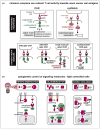Modular engineering of cellular signaling proteins and networks
- PMID: 27423114
- PMCID: PMC5127285
- DOI: 10.1016/j.sbi.2016.06.012
Modular engineering of cellular signaling proteins and networks
Abstract
Living cells respond to their environment using networks of signaling molecules that act as sensors, information processors, and actuators. These signaling systems are highly modular at both the molecular and network scales, and much evidence suggests that evolution has harnessed this modularity to rewire and generate new physiological behaviors. Conversely, we are now finding that, following nature's example, signaling modules can be recombined to form synthetic tools for monitoring, interrogating, and controlling the behavior of cells. Here we highlight recent progress in the modular design of synthetic receptors, optogenetic switches, and phospho-regulated proteins and circuits, and discuss the expanding role of combinatorial design in the engineering of cellular signaling proteins and networks.
Copyright © 2016. Published by Elsevier Ltd.
Conflict of interest statement
statement Wendell Lim is a Founder of Cell Design Labs and a member of its scientific advisory board.
Figures




References
-
- Alon U. An introduction to systems biology: design principles of biological circuits. CRC Press; 2006. p. 324.
-
- Lim W, Mayer B, Pawson T. Cell signaling: principles and mechanisms. Taylor & Francis; 2014.
-
- Slusarczyk AL, Lin A, Weiss R. Foundations for the design and implementation of synthetic genetic circuits. Nat Rev Genet. 2012;13:406–420. - PubMed
Publication types
MeSH terms
Substances
Grants and funding
LinkOut - more resources
Full Text Sources
Other Literature Sources

